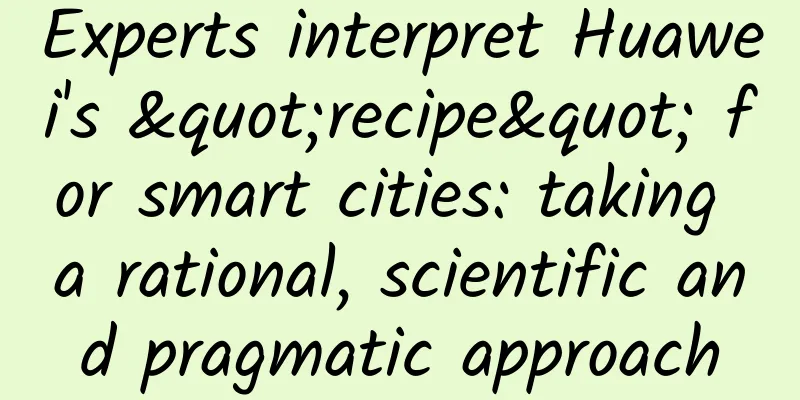AIOps implementation revealed! See how three WOT experts make AIOps a reality

|
[51CTO.com original article] On June 21, the WOT2019 Global Artificial Intelligence Technology Summit kicked off on time at the Beijing Yuecai JW Marriott Hotel. As a well-known summit for offline exchanges among global technical personnel in 2019, this conference focused on three core chapters: general technology, application fields, and enterprise empowerment. More than 60 first-line AI experts from around the world gathered together to share thematic technical content such as deep learning, neural networks, visual technology, unmanned driving, machine learning, algorithm models, and knowledge graphs with more than a thousand participants. On the afternoon of June 22, in the AIOps sub-forum of the C venue of the Enterprise Empowerment Chapter, three cutting-edge application experts, Xiao Yunpeng, R&D architect of CreditEase, Wu Jingtao, Chief Technology Officer of F5 Networks Greater China, and Chen Jun, founder and CEO of LogEasy, were invited to attend and give wonderful speeches. After the meeting, 51CTO organized the experts' speeches into articles, hoping that the essence of their speeches will be helpful to everyone. Xiao Yunpeng, R&D Architect of CreditEase: The Practice of Distributed Active Perception in Intelligent Operation and Maintenance Xiao Yunpeng divides the development of operation and maintenance into four stages: manual stage, standardization stage, automation stage, and intelligent stage. He said that the hottest concept now is intelligent operation and maintenance. In fact, whether it is AIOps or ChatOps, they solve the same problem - the balance between high complexity and high efficiency of operation and maintenance. From an engineering perspective, the heterogeneity of operation and maintenance has become stronger, and third-party applications and various devices need to be introduced. The complexity has become very high, resulting in higher and higher delivery models. People place their hopes on AIOps, hoping to bring artificial intelligence into the important links of operation and maintenance, so that machines can participate like humans and ultimately solve engineering problems. If people want to build an AIOps platform, what kind of architecture should be built? Xiao Yunpeng shared Yixin's IT operation architecture. He revealed that Yixin collects a large amount of data at the bottom layer and delivers it to the technical middle platform, operation and maintenance middle platform, and data intelligence middle platform through real-time collection analysis tools. Among them, the data intelligence middle platform generates a large amount of business data and other types of data after data analysis, while the operation and maintenance middle platform actively responds to all requests initiated by R&D and business, and systematically controls the line. "We set up a general data pipeline to pass the valuable data generated by operation and maintenance to the data intelligence middle platform, and then the data intelligence middle platform analyzes the data and will feed back these intelligent operation and maintenance judgments to the operation and maintenance middle platform based on the scenarios required by operation and maintenance." Xiao Yunpeng emphasized that Yixin's design is not to build intelligent capabilities within the operation and maintenance, but to pass these data to a truly professional platform to do this, so that the data intelligence platform can build a series of models and data. F5 Networks Greater China Chief Technology Officer Wu Jingtao: Probeless real-time application big data collection engine implementation and AIOps realization Wu Jingtao, Chief Technology Officer of F5 Greater China, emphasized that if customers use F5 as a probeless data source for application visualization, then F5 can help customers in three aspects: first, it can help with operation and maintenance, such as realizing application visualization, user behavior analysis, performance management and other functions. Secondly, in terms of business, F5 can help the IT department of an enterprise to achieve many cutting-edge operations, turning the impossible into possible, such as real-time risk control in financial institutions, probeless real-time data sources for anti-money laundering and other businesses, and upgrading and transformation of traditional businesses. The last is the help in AI. It is difficult for traditional customers to perform truly fully automated operations on AIOps because they are limited by the real-time nature of data collection, the accuracy of data analysis, network management and the limitations of arbitrary grayscale application routing control technology, but F5 can help customers solve these problems in an all-round way. According to him, F5's powerful TMOS architecture places the user's request and the server's response in two different TCPs, and installs a dual-stack architecture in front of each application. In this way, F5 becomes the network middle key of DevOps, between the WEB and the APP. Without any probes, it can monitor all data passing through the API service, which is very helpful for the main key business. Wu Jingtao divides the value brought to customers into four categories: one is user/network experience monitoring, two is user behavior analysis, three is application performance management, and four is DC operation in financial language. At the end of his speech, Wu Jingtao formally recommended F5's Application Service Technology Elite Academy to the audience. F5's Application Service Technology Elite Academy brings together a group of outstanding talents such as F5's architects, senior industry analysts, and key account managers. They all played the role of martial arts heroes, and taught the application service secrets for multi-cloud environments from multiple angles and from the shallow to the deep in the form of videos. The video courses cover three major areas: multi-cloud multi-active, application security, and AI-Ops automatic operation and maintenance, and the content covers five major scenarios: finance, telecommunications, government & enterprise, high-tech, and new retail. At present, F5's Application Service Technology Elite Academy has logged in to the 51 Academy Zone and has begun formal external promotion. Chen Jun, Founder and CEO of Logeasy: Massive Log Analysis and Intelligent Operation and Maintenance At the beginning of his speech, Chen Jun said that in order to help everyone have more advanced AIOps capabilities, LogEasy has created an intelligent log center. He showed the panoramic architecture diagram of the intelligent log center. In the architecture, the first thing to do is to support as many types of data collection and processing and analysis capabilities as possible. Logeasy supports data collection on various platforms such as Linux/Windows/AIX/HPUX, and can also connect to odbc/syslog/APM, and even mobile app tracking. Secondly, it is necessary to cooperate with some CMDB data and process work order data to facilitate correlation analysis at the business operation and maintenance level. He revealed that after the collection, they have dozens of ETL methods to ensure the real-time access of massive data, and have developed their own beaver log search engine that is more than 5 times faster than general search engines. Based on this access, the log has hundreds of SPL (Search Processing Language) instructions for statistical analysis. He regards this part as the brain of AIOps. ***, in terms of external presentation, logs can be displayed on a large screen, with alarm push, on-demand script execution, public data API and third-party platform docking, and Chen Jun believes that this is the part played by AIOps. At the end of his speech, Chen Jun also mentioned that, regarding the location of anomalies that everyone is concerned about, it is not yet possible to find the ideal root cause. The conventional approach is to rely on the collection of indicators on cloud platforms and container platforms to locate a problem on a certain machine, but specific machine analysis is still required. "From the perspective of logs, we can locate a problem in a log section of a certain machine, but it is not 100% the root cause, and subsequent query analysis is required." He said that to build an intelligent log center, it is also necessary to provide more comprehensive statistical analysis and fast query capabilities to complete the observation of the overall and detailed operating status and the immediate capture of changes. The above content is compiled by 51CTO reporters based on the speech content of the "AIOps" sub-forum of the WOT2019 Global Artificial Intelligence Technology Summit. For more complete WOT content, please pay attention to .com. [51CTO original article, please indicate the original author and source as 51CTO.com when reprinting on partner sites] |
<<: After the fourth retail revolution, three experts from WOT tell you what real smart retail is!
Recommend
Cloudie: Hong Kong/South Africa dedicated server monthly payment starting from US$50, 100M bandwidth unlimited traffic
Cloudie is a Hong Kong IDC Internet service techn...
Five CDN trends that enterprises need to track
Surging video traffic, a surge in work-from-home ...
The data of tens of millions of JD.com users are suspected to have been leaked. Human greed has given rise to the "data black industry".
[[188856]] Recently, a heavy "bomb" app...
The TCP three-way handshake is well known, but what about accidental packet loss? What about intentional non-ACK response?
1. Preface When we talk about the TCP protocol, t...
When you are with your friends and family, do you have to pass on the WiFi password by word of mouth? It’s not safe!
It's Chinese New Year! The Year of the Ox is ...
IPv6 communication principle (1) - The network card startup process that cannot be ignored
Related article: IPv6 Series - 10 Common Problems...
AkkoCloud: US/Germany/UK CN2 GIA line VPS annual payment starts from 299 yuan, 300-600M large bandwidth
AkkoCloud has launched a large number of VPSs in ...
Cisco HyperFlex, the world's most complete hyper-convergence architecture
[51CTO.com original article] Hyper-convergence is...
The role of 5G in education: enabling distance learning and virtual labs
In an era of rapid technological change, 5G is mo...
Karamay: Huawei's first cloud strategic cooperation city in the world
Karamay is a desert city that was born and prospe...
Are enterprises ready for open RAN?
The increasing deployment of 5G has brought about...
Wi-Fi 6 testing completes, global deployment to begin in 2021
The Wireless Broadband Alliance (WBA) has announc...
What is Intelligent Edge Computing?
You’ve heard of edge computing. You may have even...
Officials have spoken! 5G network full coverage is too far away, and it will take another five to eight years to achieve
Although China's 4G network is not the best i...









